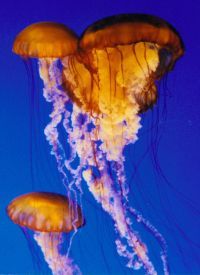
Ahoy, me hearties! Me hopes ye’ve now recovered from Talk Like a Pirate Day. Turned out to be a jolly good time here at Grist HQ aboard me ship — a good lot of pirate jokes and a few noggins o’ rum and me timbers were shivered, if ye know what I mean.
Well, this week mateys, me post was inspired by the maritime adventures of a coworker shipmate during his travels in Cabo. Apparently, after a dip in the refreshing waters, his partner started to develop a large welt — likely from a jellyfish floating stealthily nearby. The anecdote led me to mention how jellyfish had ruined many a day at the beaches where I grew up and how I thought populations were increasing due to warmer waters in recent years. Read: global warming. So I did a bit of research to find out if this is, in fact, true.
It is.
An article just this month in The Christian Science Monitor references studies done on the changing natural environments along Spain’s Mediterranean beaches. In addition to confused Arctic seals, jellyfish arrived on the coastlines this summer in droves, stinging tens of thousands of beach-goers and causing temporary closures in some areas.
Also, according to an older article in The Times, officials from Japan, China, and South Korea held a “jellyfish summit” last winter to discuss strategies for dealing with a similar invasion.
The problem first became obvious in the late summer when fishermen chasing anchovies, salmon, and yellowtail began finding huge numbers of the jellyfish in their nets.
Often the weight of the Echizen kurage [ed. note: they can reach 6 ft. wide and weigh up to 450 lbs.! blimey!] broke the nets or crushed the fish to death; those that survived were poisoned and beslimed by their tentacles.
Apparently, coastal communities in the area were/are trying to make the best of the situation by promoting jellyfish collagen as beneficial to the skin and selling it as a novelty food (dried and salted). A group of students has also managed to turn them into tofu. Surprisingly, no one has suggested peanut butter and jellyfish sandwiches. Ahem.
And because I find the creatures fascinating and eerily beautiful (see photo above; thanks, Lioness65), I now offer you a short factbox:
- The most poisonous jellyfish is the Australian sea wasp, or box jellyfish, with enough venom to kill 60 people. Wearing tights is an effective defense.
- The largest jellyfish ever found was a lion’s mane, with a bell 7 ft. across and tentacles extending more than 114 ft.
- The notorious Portuguese man o’war is not a jellyfish at all but a collection of different organisms including stinging tentacles.
- Jellyfish have both male and female characteristics. A group releases sperm and eggs, which mix in the water.
- A collection of jellyfish is known as a smack.
And now ye understand why I titled the post as I did. I do crack me-self up, I do. Har, har, arrr …


